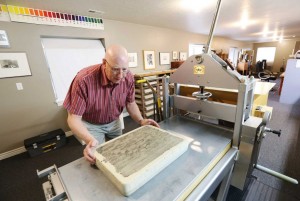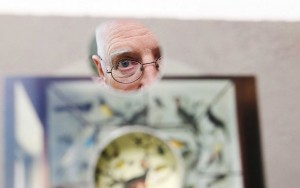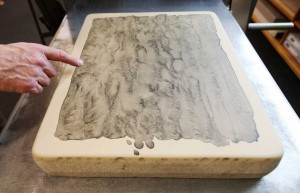
Is this a case of mistaken identity? The man in the doorway can’t be Wayne Kimball, the artist, the master printer and lithographer who slaves away in his basement studio with slabs of stone and bottles of ink for months at a time just to produce a single work of art. This can’t be the man whose often-surreal work was once described by one art aficionado as “something that one could imagine a monk doing.”
When you arrive at Kimball’s Springville home, you expect Andy Warhol; you get Fred MacMurray. The man who greets you at the door, dressed in khakis and a plaid shirt, is tall, welcoming and soft-spoken. Instead of eccentric, you get Man Next Door.
There are grandchildren playing on the floor inside, and his wife is resting in a chair. Kimball is the father of eight children and an active member of The Church of Jesus Christ of Latter-day Saints who served a two-year church mission in his youth. You’d never know it from his art, which is certainly not what you think of when you picture Mormon art.
His renderings are incredibly detailed, colorful, dreamlike collages that feature oddly juxtaposed images: horse heads and ancient statuary and leopard rugs and floating hands and potted plants and heads on a pole and a wooden chair and birds. They are tapestries of puzzles.
It’s a challenge to describe or explain Kimball’s art. Shalee Cooper gave it a good try for Utah’s Art Magazine a few years ago while writing about one of Kimball’s exhibits, which the artist playfully titled “Things Put Together By Hand Without Instructions in a Basement.” Cooper described Kimball’s art as “a realm of broken and ruined antiquity, birds, timepieces and fragmented body parts.” She continued, “The viewer, left equally without instruction, is invited to piece it altogether, a task that may require some work, but given the rich nature of these finely executed lithographs and collages, it is work well rewarded.”
As the title of that show suggests, Kimball has a dry sense of humor. He called his recent exhibit at Salt Lake’s Visual Art Institute “Things Made in a Subterranean Chamber near a fault line.” Kimball laughs. “It’s true,” he says. “My basement is on a fault line.”
If you’re not an art aficionado, then you probably don’t know Kimball or his work, but the art world does. It has been exhibited in all 50 states, as well as Great Britain, Holland, France, Italy and Germany. It is included in permanent collections throughout the U.S., most notably the National Gallery of Art in Washington, the New York Public Library, the Brooklyn Museum, the Philadelphia Museum of Art, the Phoenix Art Museum, the Utah Museum of Fine Arts, the BYU Museum of Art and many other university collections, including nearly 600 works in a special collection at Texas Tech.

Asked to describe his art, Kimball says: “It’s a little bit surreal. It’s also Dadaism, which was a group of artists who took anything from anywhere and put things together in an odd association of objects. Something from one source and something from another source; they collide.”
Ideas for his art come from everywhere. Statues seen on a trip to Italy. Tile patterns. His imagination. His own drawings. Magazines. He has filled an entire drawer with photos he has excised from magazines.
Lithography is a complicated and laborious form of printing that was invented in 1796 in Germany, and it begins with large slabs of limestone. There are only two quarries in the world — both discovered by the Romans centuries ago in Bavaria — that produce limestone judged to be suitable for lithography because of its uniformity and hardness. Drawings are made on the surface of the stone with what are essentially grease pencils, and then treated with the sticky sap of an acacia tree and coated with acid. It’s actually more complicated than that, but the end result is an image that has penetrated the stone, which — skipping many other steps — can be transferred to paper with grease-based ink.
In his large subterranean studio, the 72-year-old Kimball hefts 125-pound limestone slabs to bring his art to life. His drive and patience to create the image to his satisfaction would wear out a marathoner. For one piece alone, he repeated the aforementioned process 19 times — that is, from a complete drawing he redrew 19 separate parts of it on the limestone and printed them one at a time to re-create the total image in color. The process took a year and a half.
That is not unusual. He can spend months making trial proofs of a single image while experimenting with various colors and patterns and even the sequence in which he prints the various colors to see what he can discover.
“I’m kind of nuts,” he says.
In the computer age, there are easier ways to accomplish much the same thing, which is one reason lithography is a dying art; the field isn’t growing as digital imaging has cut out true hand-crafted printmaking. For a craftsman like Kimball, it’s the difference between a painting and a photograph, or French cooking and fast food.

“Lithography is hanging on, but just barely,” says Kimball. “Kids want that easy way. In lithography you have to get all smelly and dirty with solvents and inks. It’s manual labor. The computer images are good, but if they see them as the same thing it’s a mistake. It’s your own hand-made imagery. There’s that thing about somebody making something.
“A photograph doesn’t work for me; I get thrilled when I see an embroidered pillow that some grandma has spent months doing it. Or an engraving. Not many do it, but to look at a nice engraving is something else. The way the ink lies on the paper, the kind of lines that can be made. .”
Kimball calls himself a latecomer to art. In his formative years his only formal exposure to art consisted of one art class in junior high and a ceramics class during his freshman year in college. A graduate of now-defunct South High, he attended Southern Utah University on a football/basketball scholarship. His college football career lasted three days. “I thought, these guys are too serious,” he says. “I just wasn’t aggressive enough.” He gave up sports altogether and spent the next two years serving an LDS Church mission.
When he returned to SUU, he took more ceramics classes, but for the next year and a half he considered majors in business or psychology. “I was married and had a child,” he says. “I needed security.”
But as he continued to take art and design classes, he completed a degree in art. He attended graduate school at the University of Arizona, where he studied printmaking because, in his words: “I was not secure about my drawing. I knew I had to improve my drawing.”
In grad school, he intended to study engraving but discovered that lithography resonated with him and captured his imagination. After completing his master’s degree in fine art, he attended the Tamarind Institute at the University of New Mexico. The institute had just been created to train master printers, largely to prevent the art form from dying.
After becoming only the 20th student to graduate from Tamarind with a master printer certification, Kimball was awarded a grant to serve as an artist in residence in Roswell, New Mexico. For an artist, it didn’t get better than that.
“They paid me to do art,” he says. The grant included a furnished house, a studio, supplies and a one-man show in the Roswell Museum and Art Center. He might have stayed indefinitely, but six months later something else came along during a visit to Chicago, where his father was serving as president of an LDS mission. While attending a workshop there, Kimball was encouraged to interview for a position at the University of Wisconsin, a mecca for printmaking in 1972. He was hired on the spot.
“That started the ball rolling,” he says. “I had no trouble getting a job after that.”
In the coming years he spent a year at Wisconsin, a year at San Diego State University, a year at Cal State-Long Beach, two years at Texas-San Antonio, another year at San Diego State, six years at Arizona State and then 25 years at BYU.
“I was a migrant worker,” he says.
He retired from BYU in 2009. He and his wife, Pamela, who is battling cancer, dote on their grandkids, and he still pursues his art in his subterranean studio near a fault line.
“It’s a tremendous blessing,” Kimball says. “It distracts me from Pam’s malady. When I’m not doing something with her or running errands, I’m hanging out in my studio. I love it. It’s really fun.”




